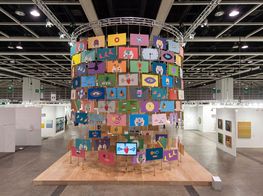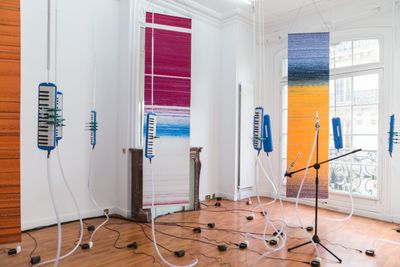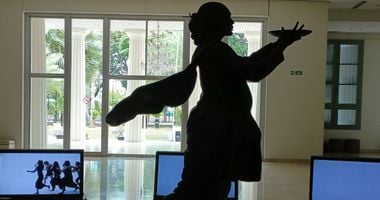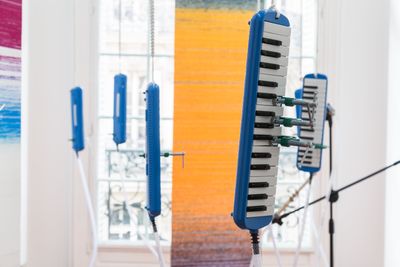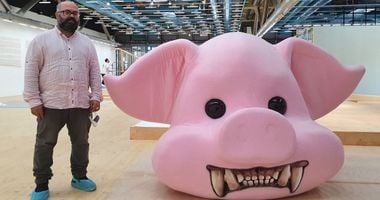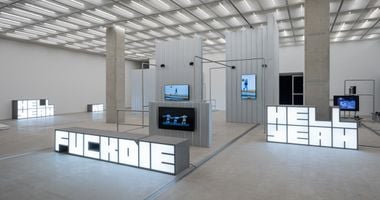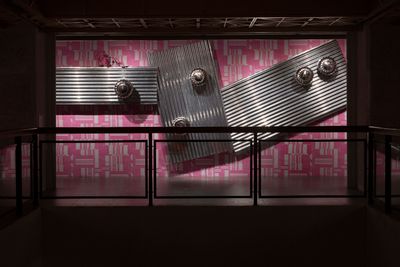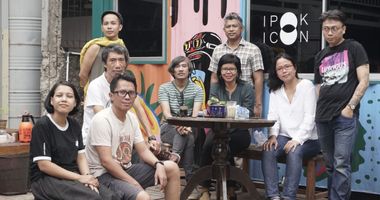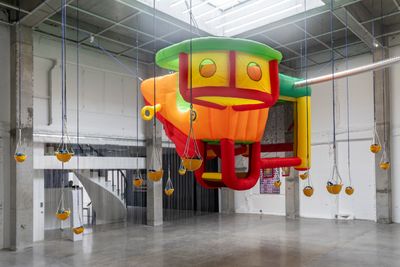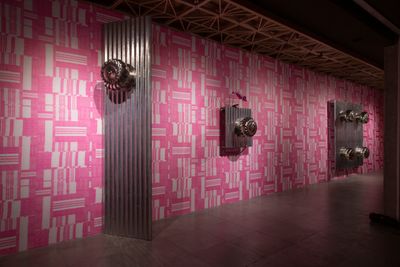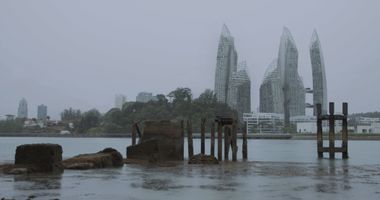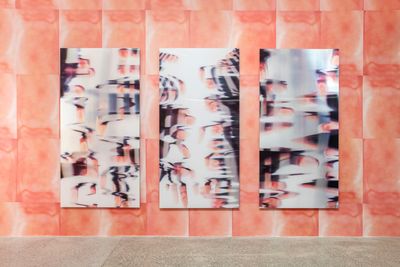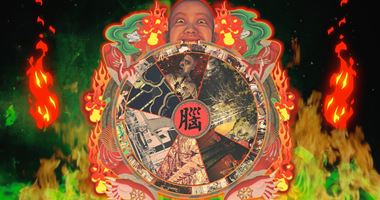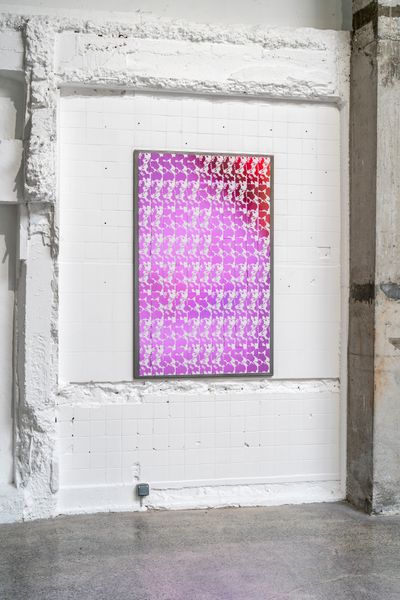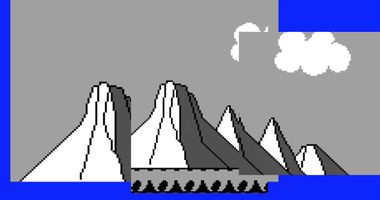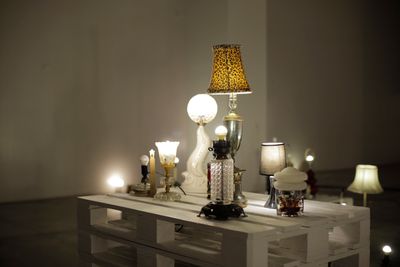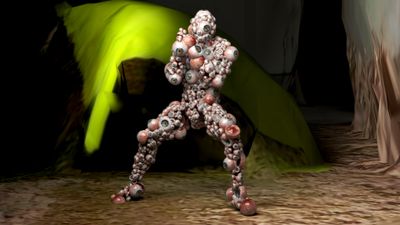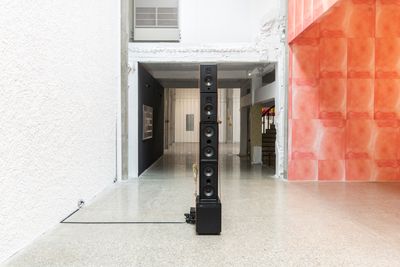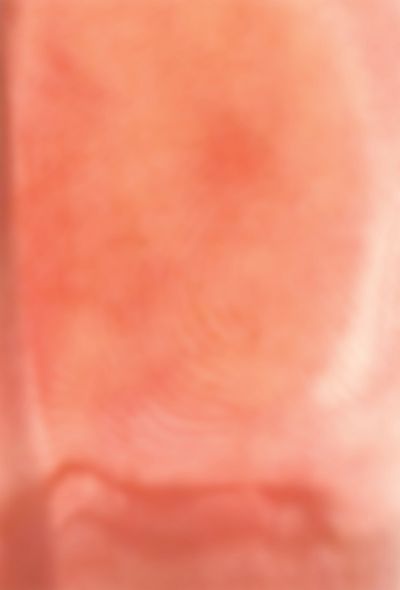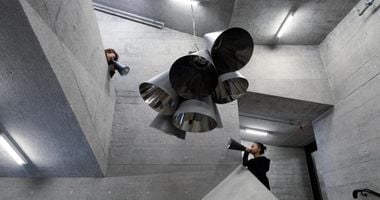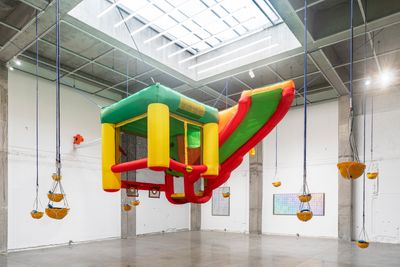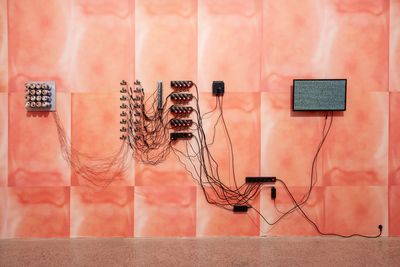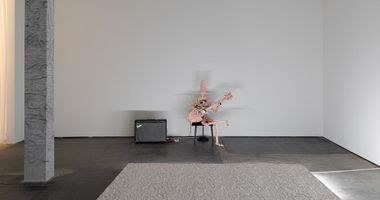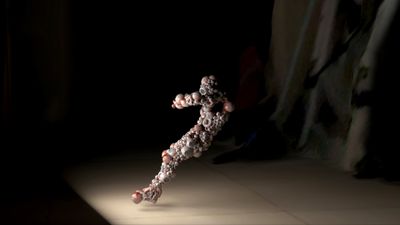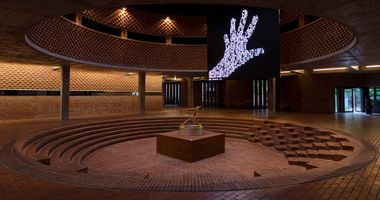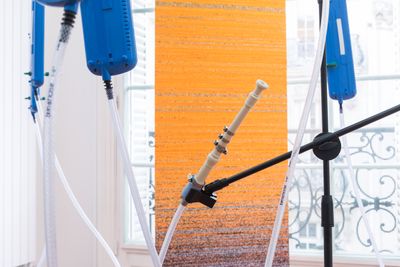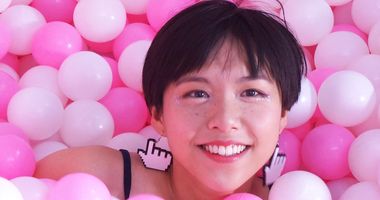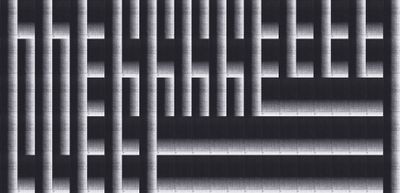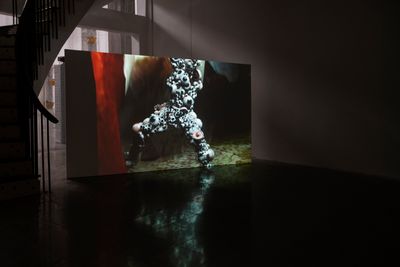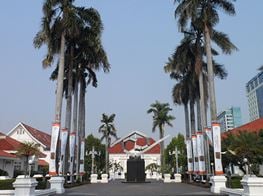Tromarama: Rethinking the Locales of the Global System
In Partnership with ROH
Tromarama (2022). Courtesy the artists and ROH.
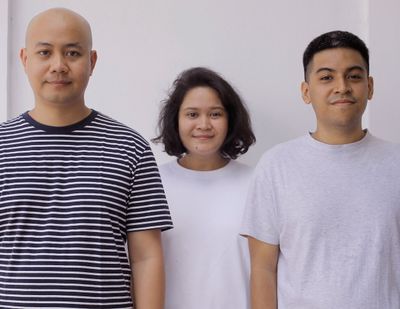
Tromarama (2022). Courtesy the artists and ROH.
It's fitting that Febie Babyrose, Ruddy Hatumena, and Herbert Hans met at the Bandung Institute of Technology, forming the collective Tromarama there as students in 2006. Since then, they have developed a practice that has tracked technology's unceasing ability to reshape the world in real time.
For the collective's first solo exhibition in the United States with DOCUMENT (5 June–8 August 2021), Tromarama presented Beta (2019), an algorithmic installation visualising the destabilisation of coherent identities, traditionally categorised through the territorialised form of the nation state, that technology facilitates.
Melodicas hanging from the ceiling are activated by computer software that seeks out tweets using the hashtag #nationality. Beta decrypts these tweets to trigger notes on each melodica to form the Indonesian national song, 'Berkibarlah Benderaku' or 'Rise, My Flag', which elementary students in Indonesia are required to perform in order to graduate.
The term 'beta' recalls both the formulation for 'I' or 'myself' in classic Malay literature, as well as the secondary testing phase in software development: an enmeshment of meaning and temporalities mirrored in the chorus of dissonant, incoherent sounds that Beta produces.
Beta's resulting choral effect mirrors the flickering lights of Soliloquy (2018), another of Tromarama's algorithmic works. Consisting of 96 lamps sourced from a flea market, Soliloquy is activated by software that converts tweets with the hashtag #kinship into code, which triggers each lamp into a flash dance.
Soliloquy is among the works included in a mind map that Tromarama created to conceptualise their latest exhibition, PERSONALIA, at ROH in Jakarta (20 August–2 October 2022). Also featured in this map is the first installation the collective made that incorporated algorithms, 24 hours being others (2017), and their recent algorithmic work Marjin (2022).
24 hours being others consists of three printers connected to software that harvests tweets associated with each component of the work's title. The system then prints these tweets onto A5 paper, omitting their associated account handles and timestamps and thus erasing all sense of identity attached to them.
'We wanted to think through the relationship between the individual and the algorithm, which shapes so much of how we perceive reality nowadays,' the collective explains. Marjin extends this study. Mounted upon corrugated zinc sheets of varying sizes, a series of 16 turbine ventilators is activated by rotary fans linked to software seeking out the hashtag #pleasure.
Developed for a particular site, Sarinah, Indonesia's first department store, Marjin was conceived with the economy in mind. The work provided the starting point for PERSONALIA, with its use of the hashtag #pleasure referring to the utilisation of pleasure as an economic tool.
'We may think of a social media platform as a playground to spend our free time,' the collective points out. 'But we are actually working: it's a new model of economic production where our activity becomes commodified into work.'
Feeding back into Tromarama's ongoing algorithmic projects since 2017, PERSONALIA extends the ideas posed in Marjin. The exhibition amplifies the collapsing divisions between labour and leisure within a system predicated on an endless loop of production and consumption.
Among the works on view are a series of new algorithmic installations that Tromarama introduces in the following conversation, which reflects on the real-world effects of an ever-evolving post-internet economy.
SBAt its core, PERSONALIA is a study of the blurred lines between leisure and labour—an idea that departs from Marjin, which considers how the online space turns pleasure into profit, and social media users into 24-hour workers. Could you talk about that?
HHWith Marjin, we are talking about the factory space, or the economy before the internet. Back then, workers used punch cards as attendance records that documented the time they spent at work, which led us to reflect on the notion of control.
The punch card is an index of productivity, and a tool or a system of control. But in this new economy, with the rise of technology and the internet as a means to surveil and capitalise on productivity, systems of control have multiplied. That's the paradox about the post-internet economy: while I'm voluntarily connecting with an online society through social media, it's another form of control.
FBIn PERSONALIA, a series of screenprints made with attendance records and gold-and-aluminium foils, speaks about how our presence on any online platform becomes that platform's capital, hence the choice of gold foils. It's a new mode of the economy: we no longer need attendance records or punch cards to prove our presence; we just need our image or reflection.
As part of the exhibition, we have covered the walls in one gallery with images of scanned thumbs created with offset lithography. The thumb is the backbone of the social media realm: we can physically do so much just by tapping and swiping our thumbs. Three lenticular pieces in this space are based on that idea: Beyond the cloud, Left right, and Like, like, like (2022) record and disperse the performativity of these scanned thumbs.
Then we have three 3D-printed pieces of our faces, which speak to how, in the pre-internet era, we needed to submit our identity card as proof of attendance at work. But now, we barely need verification to prove our existence in the realm of social media.
SBBecause by swiping into the online realm, you are effectively activating your reflection in that space, and announcing your attendance on a platform where leisure is quantified as labour...
FBWe also have a screenprint made with attendance records and foils printed with images of orchids, which relates to Marjin, where our use of the orchid originates. In our research, we learned that big corporations in large cities in Indonesia, such as Jakarta, tend to display an array of orchids in their office spaces. They actually outsource a vendor who rents these orchids for a period, and when the orchids wither, they are replaced with fresh ones.
We find similarities with these orchids in terms of how they are treated like labour in the digital age. When we are online, we are useful: we become capital, just like when the orchids are in bloom. Once we go offline, we are no longer capital, just like when the orchids wither.
SBI'm reminded of a show you did in 2015 in Hong Kong, Panoramix, which communicated this collapse between the real and the virtual. With PERSONALIA, it seems that you're visualising the collapse of divisions not only between real and virtual, but also work and leisure.
This collapse reveals a paradox—as much as these systems that are facilitating and defining how society lives and works expand, there is also a contraction. Freedom, and perhaps more specifically time, becomes limited by the very systems that enable society to operate on all levels, from the personal to the political.
That's the paradox about the post-internet economy: while I'm voluntarily connecting with an online society through social media, it's another form of control.
This recalls your use of everyday objects and hashtags, as with Soliloquy and its activation of second-hand lamps with tweets using the hashtag #kinship, which relates to the relations between the individual and collective. How would you describe those relations?
HHWe chose to use second-hand lamps because they each have their own history. By developing an awareness of these histories—and of each other's stories—we can develop kinship not only with ourselves, but with each other in the digital realm.
RHI think one of the interesting shifts for us personally is how we see the works that we create using algorithms.
At first we saw the work as participatory, but we started to perceive that participation in a more unconscious way. While we use people's activity on social media platforms, we look at this participation through the perspective of data capitalism. Unconscious participation is how companies use our data, which in turn expands the definition of labour and changes how we see that system.
It's interesting to see how we perceive people participating in our work, even when we are doing what big companies are doing. We are using unconscious participants in the creation of our work through the hashtags we monitor. But they have no idea how we are using that data. We don't encourage participation in our projects, and we don't invite people to use a particular hashtag. People don't know we're running their hashtags into a workflow.
It's also important to point out that without an internet connection, these works would not be possible; they wouldn't be activated if no one used Twitter or those specific hashtags in their tweets. It's an important factor of the work that people are online and tweeting.
SBNo one knows you're harvesting their data, which speaks to how you reroute this unconscious participation towards an artwork that is critiquing the system it is making visible while capitalising on it.
RHFor PERSONALIA, we created a video of an eyeball figure to respond to how our attention is constantly harvested, measured, and targeted.
We worked with a dancer, Jessica Christina, and shared our intention to develop several gestures resembling how we interact on social media. Jessica's performance was recorded and processed by motion-capture software that converted her body movements into a three-dimensional robot.
This robot was then retargeted by eyeballs, producing this figure that moves in a virtual space created from photogrammetry of Febie's house in Jakarta. The background of the house responds to the phenomenon of how the boundaries of being at home and being at work are blurred.
FBWe have also created a found-object installation from a stack of daily calendars around 150 centimetres in height, topped with a functioning retro flip clock. The daily calendars portray three calendars at once: Chinese dates, Javanese dates, and Arabic dates. The numbers on the retro flip clock are taken out to highlight the post-internet economy in which working time becomes unclear.
SBThis idea of unconscious participation in the post-internet economy feels like one side of the coin in terms of your algorithmic sculptures. In an exhibition, these works create an encounter between unconscious and conscious participation, because audiences in the gallery are aware of their engagement.
Does this mean that every time you stage one of your algorithmic works, their manifestation is determined by their present reality? This includes how a hashtag operates in real time, how well a social media platform is running, and who has decided to come and see the works in person...
HHOne of the things that we are addressing is a 'shadow'. When each word manifests as a hashtag and is staged in an exhibition, it is really a fixed shadow—but how it is made, and who it is made by, is always changing.
When people project themselves in social media, into a digital realm, they project their own shadow. That shadow could manifest in the form of a hashtag on Twitter, for instance, and we try to manifest this shadow into a different set of installations.
The first work visitors will see in PERSONALIA is a binary-synth installation whose form is created by speakers that are intentionally stacked to resemble a human figure. We have created custom-made software generated by a specific hashtag, #asset, and every time someone tweets #asset, the software will harvest this tweet and convert it into a set of binary codes that will play pre-programmed notes.
The binary-synth consists of 16 channels, each playing a sound font extracted from the ultrasound of a foetus. The utilisation of ultrasound was conceived when I first experienced the presence of mine and Febie's child, Gala 'Bitta' Bittara Tobyn, in an ultrasound examination. I could not physically experience Bitta's presence when she was a foetus, only Febie could, but through ultrasound technology, it was made possible.
With that in mind, an important keyword for this installation is 'bonding', which relates to how we want to ignite a bond between the visitor and another human being through the ultrasound element, while translating this experience into how one attempts to bond through social media. Our choice of the hashtag #asset is also related to how the presence of others becomes the asset we seek to find when surfing social media.
...this frontend of a global system tends to push us into singularity, which is quite paradoxical, because in the backend it's very local.
SBSo through this installation, each user, who is unconsciously participating in the production of the work in the exhibition, becomes an iteration of the 'shadow' that inhabits social media?
HHOne of the main reasons this installation welcomes visitors to PERSONALIA is so they can immediately feel the presence of another person upon entering the show. Ultrasound technology and digital media both become the mediator for one to experience the presence of another. It could be said that this personal experience is analogous to how humans interact and experience other humans through the conduit that is social media.
SBThis makes me think about the hashtag in relation to the everyday object, where you take something ubiquitous like a lamp, and highlight its uniqueness by amplifying its existence as something with its own stories; that once belonged to someone.
The same could be said of a hashtag, whose keyword could mean something different to each user, just as people can read a single artwork in very different ways—such that an artwork operates like a hashtag. Could you talk about how PERSONALIA translates these ideas into space?
Take Patgulipat (2022), for example, the bouncy castle installation shown alongside floating work helmets.
HHThat upside-down bouncy castle connects to how each of us in the collective have children, and how we have had to accompany them to the playground. In our discussions around social media, where we seem to play at the same time as we are working, we thought about how children play in the playground without any notion of work in their minds, which seems to relate to our state of mind when we are online.
The bouncy castle is an object that is never associated with work, just as social media is not necessarily associated with labour, even if it is effectively a workplace with a workforce.
FBAlongside the inverted bouncy castle, there are 16 hanging helmets that each hold a speaker emitting sounds that are defined by the online use of the hashtag #assignment. The installation aims to show how the definition of labour and leisure have become blurred in the post-internet economy.
HHPERSONALIA also includes an installation of 16 Red Bull cans, each with a speaker inside that plays a distorted recording of our voices, which are triggered by software programmed to seek out tweets with the hashtag #force. We see Red Bull cans in a similar way to how we see second-hand lamps: each can has its own story about someone struggling to finish their work.
SBRed Bull is one of the many stimulants, like coffee or coke, used to meet the incessant pace of productivity that the economic system demands. Pleasure, in the form of a soft drink, is again rerouted towards labour productivity. This speaks to your conflation of the playground with the workplace in the bouncy castle—it looks fun, but it's speaking to something darker.
I am reminded of your collective name Tromarama, which stems from your experience making woodcuts for an animation about a band in Indonesia in 2006—a process that was so labour intensive you described it as a trauma; hence Tromarama, traumatic vision. Is this traumatic vision PERSONALIA's subtext?
FBYour question reminds me of the exhibition we did for the children's space at Museum MACAN in Jakarta, The Lost Jungle (2021). The exhibition talked about extinction and the domination of nature, which is mirrored in how we, as spectators, go inside the exhibition space—because it's humans that cause animals to go extinct, just as it's humans who reflect on that extinction as it happens in an exhibition.
But we wanted to enter this conversation from a kid's perspective, so we created a space that moved into the imaginary, where we invited kids to use their imaginations to create their own animals based on those that have been extinct for quite a long time.
Of course, there is an irony to that invitation, because we were talking about extinction caused by humans, and we were asking kids to think about this by creating animals to populate a digital jungle on a big screen. So as you said before, it's playful and dark. But I think that's the way we communicate through our work.
SBWhen you talk about dealing with extinction by inviting kids to imagine animals, it really opens up a reading of your work through the idea of generation. To imagine something is generative, just as a hashtag generates conversation; the capitalist system is also designed to generate, just like your algorithmic works.
With this in mind, how does your installation Beta fit into this? It's not included in PERSONALIA, but the hashtag it focuses on, #nationality, relates to the generative global system this exhibition confronts.
HHWhile we were making Beta, we reflected on how the imagination of the nation pops up in our minds. When we were in elementary school, we needed to perform a national song—in fact, the performance of that song was the final assignment we had to do in order to complete the term.
But when the internet arrived, it was like a melting pot of values and perspectives—we were exposed to so many belief systems online that we reached a point where we started to question our own beliefs and values.
That's how Beta began to manifest. The instruments we used for Beta are the ones we had to use to perform the mandatory anthem at school. Like the punch card that records people's attendance at work, we see those instruments, like a national song, as one of many instruments that controlled us before the internet.
SBSo Beta is a work about that crossover; the instruments of a pre-internet system of control enmeshed with an emerging system, which PERSONALIA unpacks. In that sense, Beta seems to be a statement about post-nationalism, because it acknowledges a multidimensional way of experiencing the world by tapping into 'nationality' as a collection of dissonant individual perspectives.
When thinking about the dynamics between the individual and collective within a space like the internet, issues of the local and the global come to the foreground. How do you negotiate these issues as a collective? Your works engage with very broad, let's say universal, ideas: kinship, pleasure, being.
RHBecause we are using general hashtags, and not geolocated tags—which is the case in some of our works where we use weather data and address specific geolocations—the tweets that are fed into the software could be from anywhere. So in a way, these algorithmic works are very universal. They are relatable.
HHWhat makes the work local is the software that runs and collects the data, and the specific place or region where the software is activated at a given time. For example, when one of our algorithmic works is shown in Shanghai, the algorithm's search would be affected by Twitter's accessibility in China, or we would have to use a V.P.N.
SBSo it's like how Google works—the information you receive depends on where you are in the world.
HHWhen you think about it like that, the local is happening in the backend and not at the frontend.
SB'The local is happening in the backend' is an amazing description. It reminds me of the book Market Civilisations (2022), edited by historian Quinn Slobodian and political scientist Dieter Plehwe.
Market Civilisations challenges the idea that neoliberalism is a top-down implementation from the West onto the rest of the world, and proposes that it's actually a system that has been individuated within each place it is implemented. So neoliberalism is a local system in the backend, but it's often perceived as something homogenous and globalised on the frontend.
HHYes, and this is also one of the things we talk about as a collective—how this frontend of a global system tends to push us into singularity, which is quite paradoxical, because in the backend it's very local.
RHSpeaking about how this singularity comes through in our daily lives, my son is four years old and through watching YouTube every day, he picks up the English language very fast. He actually prefers to talk in English, more than he likes to speak in our own language. I also have a friend in Yogyakarta whose son feels more comfortable speaking in English, and has to take Indonesian language lessons.
Thinking about the local and the global, the younger generations are experiencing something more extreme. This is a global society of digital natives; there are generations growing up around the world that are talking the same way. It's really a blur now, and it will be interesting to see the effects of this. —[O]

